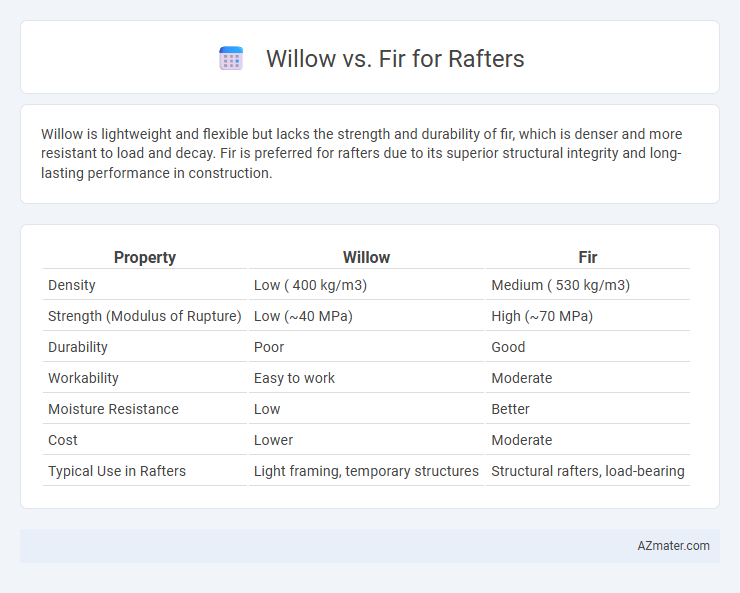Willow is lightweight and flexible but lacks the strength and durability of fir, which is denser and more resistant to load and decay. Fir is preferred for rafters due to its superior structural integrity and long-lasting performance in construction.
Table of Comparison
| Property | Willow | Fir |
|---|---|---|
| Density | Low ( 400 kg/m3) | Medium ( 530 kg/m3) |
| Strength (Modulus of Rupture) | Low (~40 MPa) | High (~70 MPa) |
| Durability | Poor | Good |
| Workability | Easy to work | Moderate |
| Moisture Resistance | Low | Better |
| Cost | Lower | Moderate |
| Typical Use in Rafters | Light framing, temporary structures | Structural rafters, load-bearing |
Introduction to Willow and Fir as Rafter Materials
Willow and fir offer distinct characteristics as rafter materials, with willow prized for its lightweight and flexibility, enabling easier manipulation during construction. Fir is known for its strength, straight grain, and dimensional stability, making it a preferred choice in structural applications requiring durability. Both woods provide sustainable options, but fir generally outperforms willow in load-bearing capacity and resistance to warping over time.
Strength and Durability Comparison
Fir is generally stronger and more durable than willow for rafters due to its higher density and resistance to bending and warping under load. Willow, being softer and less dense, lacks the structural integrity required for heavy roofing support and is more susceptible to moisture damage and decay over time. Fir's superior strength and natural durability make it the preferred choice for long-lasting and reliable rafter construction.
Weight and Workability Factors
Willow wood is significantly lighter than fir, weighing approximately 360 kg/m3 compared to fir's average density of 530 kg/m3, making willow easier to handle during rafter installation. Fir offers superior workability due to its straight grain and fine texture, providing better strength and stability for structural applications like rafters. The lower weight of willow reduces labor fatigue, but fir's enhanced durability and resistance to warping make it a preferred choice for long-lasting rafter frameworks.
Cost and Availability Analysis
Willow rafters are generally more affordable due to the fast growth rate and widespread availability of willow trees, making the material cost-effective for large-scale construction. Fir rafters, while slightly more expensive, offer greater structural strength and stability, with consistent supply in commercial lumber markets ensuring reliable procurement. Cost analysis favors willow for budget-sensitive projects, but fir's availability and performance often justify the higher investment in roofing frameworks.
Resistance to Decay and Insects
Fir rafters offer superior resistance to decay and insect damage compared to willow, making them a more durable choice for structural applications. Fir wood contains natural resins and tighter grain patterns that enhance its durability against environmental threats. Willow, while lightweight and flexible, is more prone to rot and insect infestation, requiring additional treatment for long-term use in rafters.
Environmental Impact and Sustainability
Willow wood, known for rapid growth and carbon sequestration, offers greater sustainability compared to slower-growing fir, reducing deforestation pressure. Fir rafters provide structural strength but involve longer maturation times, leading to higher environmental costs. Choosing willow supports eco-friendly construction practices through renewable resource management and lower carbon footprints.
Aesthetic Differences in Rafters
Willow rafters offer a rustic, natural look with a lighter color and distinctive grain patterns that create a warm, organic aesthetic ideal for traditional or country-style interiors. Fir rafters provide a clean, more uniform appearance with a reddish-brown hue and tight grain, lending a modern, sophisticated touch to architectural spaces. The choice between willow and fir rafters significantly influences the visual character of a structure, balancing natural charm against polished elegance.
Best Uses for Willow Rafters
Willow rafters offer lightweight flexibility ideal for temporary or decorative roofing structures, providing excellent shock absorption in garden pergolas or rustic gazebos. Their natural resistance to splitting makes willow rafters suitable for curved or intricate designs, unlike the rigid fir rafters best used in standard construction. Willow rafters excel in eco-friendly applications where sustainability and aesthetic appeal are priorities.
Best Uses for Fir Rafters
Fir rafters are highly valued in construction for their exceptional strength, durability, and resistance to warping, making them ideal for supporting heavy roof loads and long spans. Unlike willow, which is softer and less stable, fir provides superior structural integrity in framing applications, ensuring longevity and safety in both residential and commercial buildings. Their natural resistance to decay and insects further enhances fir rafters' suitability for outdoor and load-bearing structures.
Choosing the Right Wood for Your Rafters
Willow wood is generally unsuitable for rafters due to its low density, poor load-bearing capacity, and susceptibility to decay, making fir a superior choice for structural support. Fir offers excellent strength-to-weight ratio, natural resistance to warping, and durability under load, ensuring long-lasting stability in roofing constructions. Selecting fir for rafters enhances the structural integrity and safety of buildings, meeting standard construction requirements effectively.

Infographic: Willow vs Fir for Rafter
 azmater.com
azmater.com